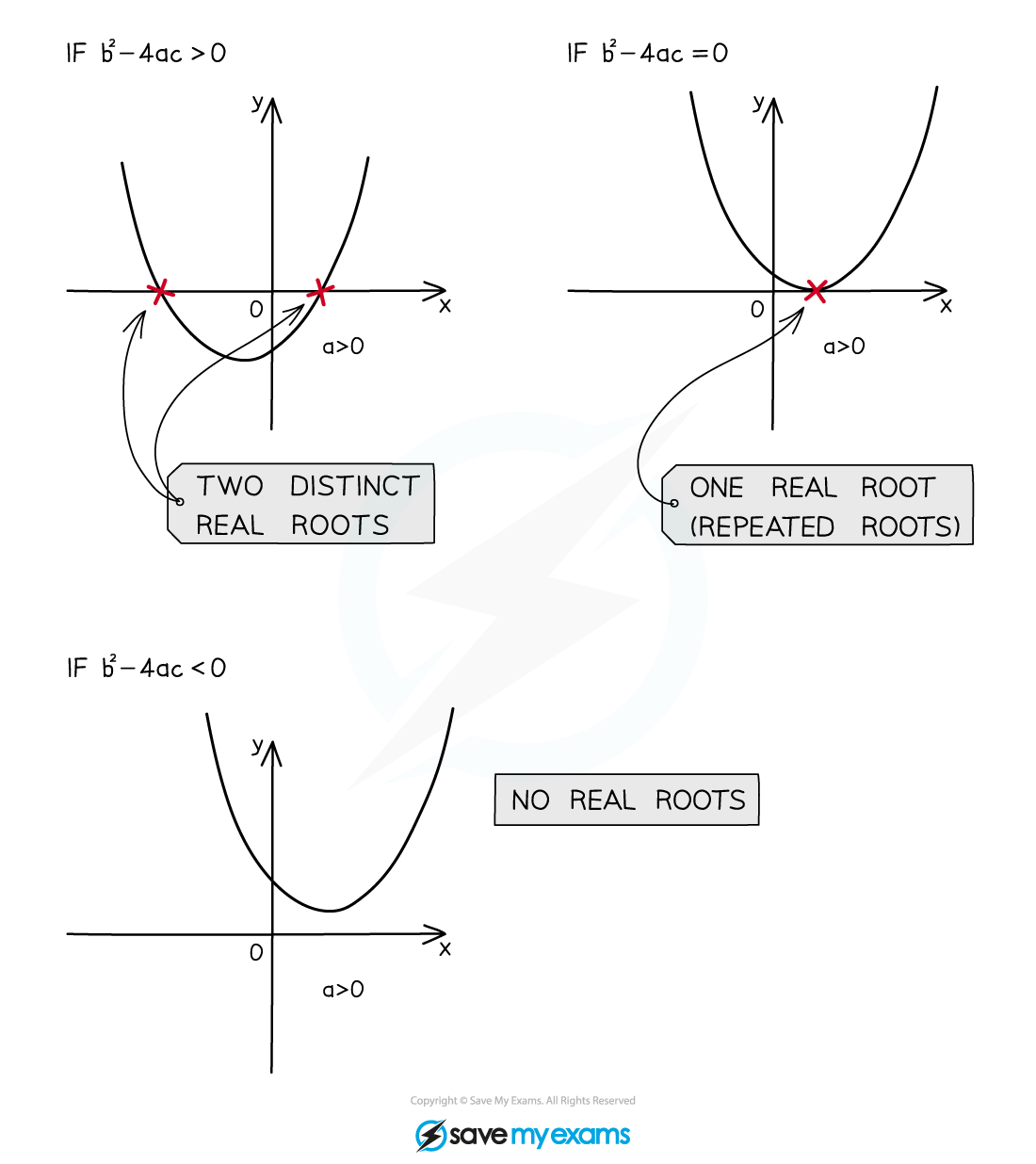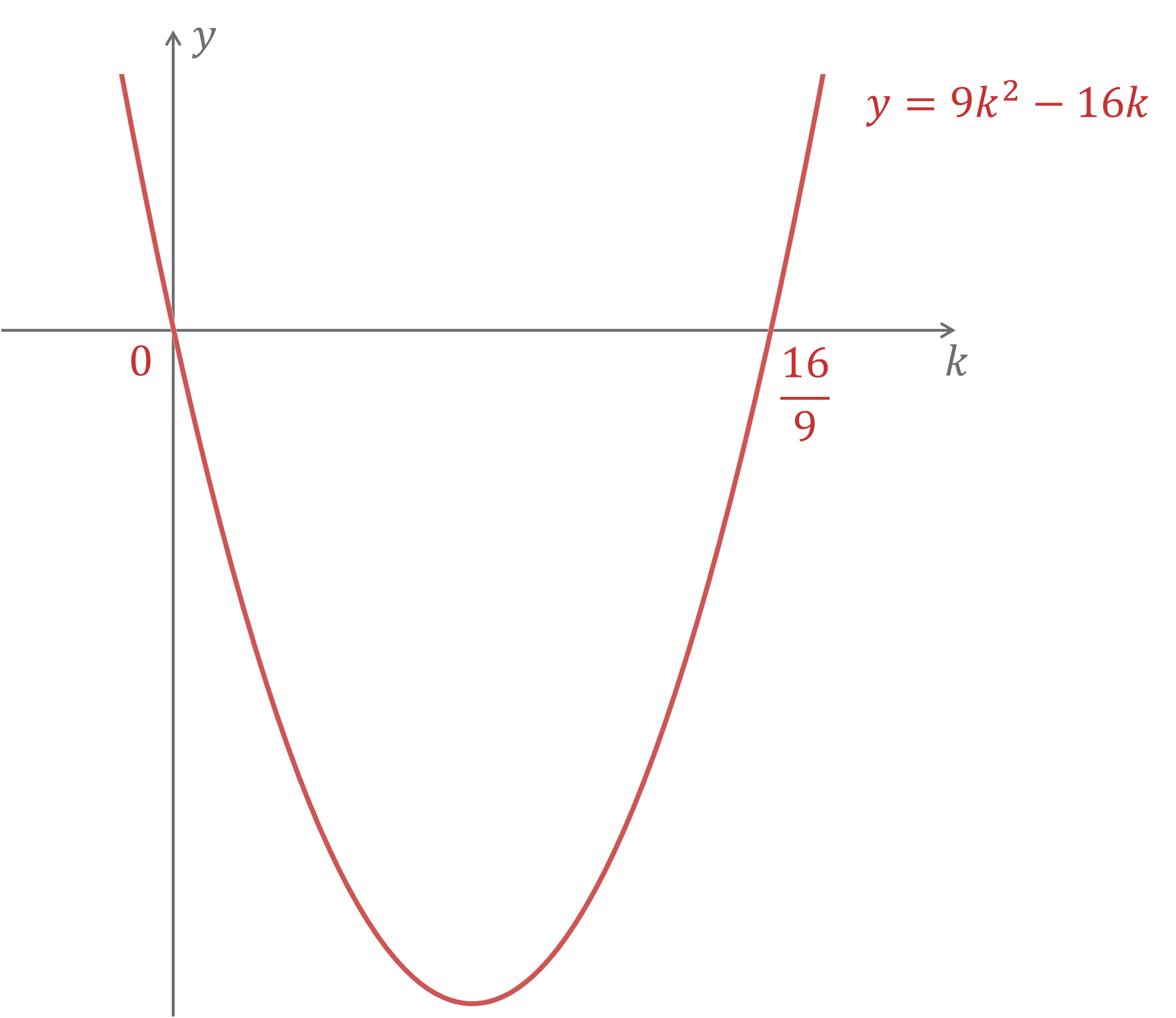Roots of Quadratic Equations (Edexcel IGCSE Further Pure Maths): Revision Note
Exam code: 4PM1
Discriminants
What is the discriminant of a quadratic function?
The discriminant of a quadratic is often denoted by the Greek letter
(upper case delta)
For a quadratic
the discriminant is given by
The discriminant is the expression that is inside the square root in the quadratic formula
This is not on the exam formula sheet so you need to remember it
How does the discriminant of a quadratic function affect its graph and roots?
The discriminant tells us about the roots (or solutions) of the equation
It also tells us about the graph of
If Δ > 0 then
and
are two distinct values
The equation
has unequal real roots
i.e. there are two distinct real solutions
The graph of
crosses the x-axis twice
If
then
and
are both zero
The equation
has equal real roots
i.e. it has one repeated real solution
The graph of
touches the x-axis at exactly one point
This means that the x-axis is a tangent to the graph
If
then
and
are both undefined
The roots of the equation
are not real
i.e. it has no real solutions
The graph of
never touches the x-axis
This means that graph is wholly above (or below) the x-axis

How do I solve problems using the discriminant?
Often at least one of the coefficients of a quadratic will be given as an unknown
For example the letter
may be used for the unknown constant
You will be given a fact about the quadratic such as:
The number of real solutions of the equation
The number of roots (i.e. x-intercepts) of the graph
To find the value or range of values of
Find an expression for the discriminant
Use
Decide whether
,
or
If the question says there are real roots but does not specify how many then use
Solve the resulting equation or inequality for
Examiner Tips and Tricks
Questions won't always use the word discriminant
It is important to recognise when its use is required
Look for
a number of roots or solutions being stated
whether and/or how often the graph of a quadratic function intercepts the
-axis
Worked Example
A function is given by , where
is a constant. The graph of
intercepts the
-axis at two different points.
a) Show that .
The question says the graph 'intercepts the x-axis at two different points'
This means that the discriminant is greater than zero
Here ,
, and
Expand the brackets and collect terms
b) Hence find the range of possible values of .
Solve the inequality, beginning by factorising
This tells us the graph of intercepts the horizontal axis at
and
It can be helpful to sketch a graph here

will be true to the left of 0 and to the right of
Write these down as inequalities
Sum & Product of Roots
How are the roots of a quadratic equation linked to its coefficients?
A quadratic equation
(where
) has roots
and
given by
i.e. the solutions found by the quadratic formula (or any other solution method)
This means the equation can be rewritten in the form
Note that
It is possible that the roots are repeated, i.e. that
You can then equate the two forms:
Then (because
) you can divide both sides of that by a and expand the brackets:
Finally, compare the coefficients
coefficients:
Constant terms:
Therefore for a quadratic equation
:
The sum of the roots
is equal to
The product of the roots
is equal to
You don't need to prove these results on the exam
But you need to be able to use them to answer questions about quadratics
They are not on the exam formula sheet
So you need to remember (or be able to derive) them
You can use them
to find the sum and product of the roots if you know the equation
Just substitute
,
and
into the formulae
or to find the equation if you know the sum and product of the roots
See the next section
How do I find a quadratic equation from information about its roots?
You may be given the sum and product of an equation's roots and then asked to find the equation
Usually the equation will need to have integer coefficients
For example "A quadratic equation has roots
and
, where
and
. Find a quadratic equation with integer coefficients that has roots
and
."
STEP 1
Start with the formulae linking the roots and coefficientsSo
So
STEP 2
Choose a value for, and find the corresponding values for
and
Choose a value for
that will multiply to make the values for
and
into integers
Let
Then
And
STEP 3
Write down the equation using your values for,
and
Note that the answer is not unique
Any multiple of the equation will also have the same roots
e.g.
How do I find a quadratic equation with related roots?
You may be asked to find a quadratic equation whose roots are related to the roots of another quadratic equation
I.e. whose roots are expressed in terms of the roots of the first equation
You will often need algebraic tricks to write other expressions with
and
in terms of
and
and
are the roots of the first quadratic
For example:
Then if you know the values of
and
from the first quadratic, you can use them to find the sum or product of the new roots
For example "A quadratic equation has roots
and
where
and
. Form a second quadratic equation with integer coefficients that has roots
and
."
The sum of the new roots is
We can use the substitution for
from above
So
The product of the new roots is
So
With the sum and product we can form the equation as described in the last section
Worked Example
The roots of the quadratic equation are
and
.
Given that and without solving the equation,
(a) show that
Use and
to find the sum and product
Express in terms of
and
Substitute to find the value
Take the square root, remembering the
Finally, use the fact that
But , therefore
(b) form a quadratic equation, with integer coefficients, which has roots and
Start by finding the sum and product of the new roots
Now use and
Select so
and
will have integer values
And finally use those coefficients to write the new equation

Unlock more, it's free!
Did this page help you?